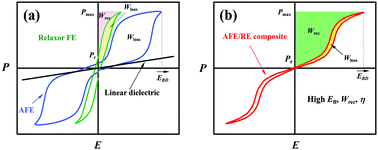Relaxor/antiferroelectric composites: a solution to achieve high energy storage performance in lead-free dielectric ceramics
Abstract
Recently developed Na1/2Bi1/2TiO3 (NBT)-based relaxor ferroelectric ceramics are promising lead-free candidates for dielectric energy storage applications because of their non-toxicity and outstanding energy storage properties. Their commercialization currently faces a challenge in that high recoverable energy-storage density (Wrec) and high energy-storage efficiency (η) cannot be achieved simultaneously. Different from the normal relaxor ferroelectrics whose energy storage density was improved by reducing the remanent polarization and increasing the electric breakdown strength, in this work, a lead-free antiferroelectric (AFE) was utilized to partially replace the NBT-based relaxor (RE) to change the shape of the polarization curve and increase the electric breakdown strength, while maintaining large maximum polarization. Based on this concept, a lead-free RE/AFE 0.94(Na0.82K0.18)1/2Bi1/2TiO3–0.06FeNbO4/0.96NaNbO3–0.04CaZrO3 (NKBT–FN/NN–CZ) composite ceramic is designed and investigated. Through heat treatment of powder and the traditional solid phase reaction method, NKBT–FN/NN–CZ relaxor/antiferroelectric composites with multi-phase structure of an antiferroelectric embedded in a relaxor ferroelectric were established, and narrow and oblique double hysteresis loops were achieved in these composites. A high Wrec of 2.85 J cm−3 and high η of 80% were simultaneously realized at the composition with a mass ratio of 70/30 at room temperature (RT). Furthermore, the newly developed composites exhibit better energy storage characteristics at 120 °C, with a high Wrec of 3.5 J cm−3 as well as a high η of 91%. This study demonstrates that the design of a relaxor/antiferroelectric composite provides a highly effective method to improve the energy storage performance of lead-free ceramics.

- This article is part of the themed collections: Journal of Materials Chemistry C HOT Papers and Journal of Materials Chemistry C Lunar New Year collection 2021


 Please wait while we load your content...
Please wait while we load your content...